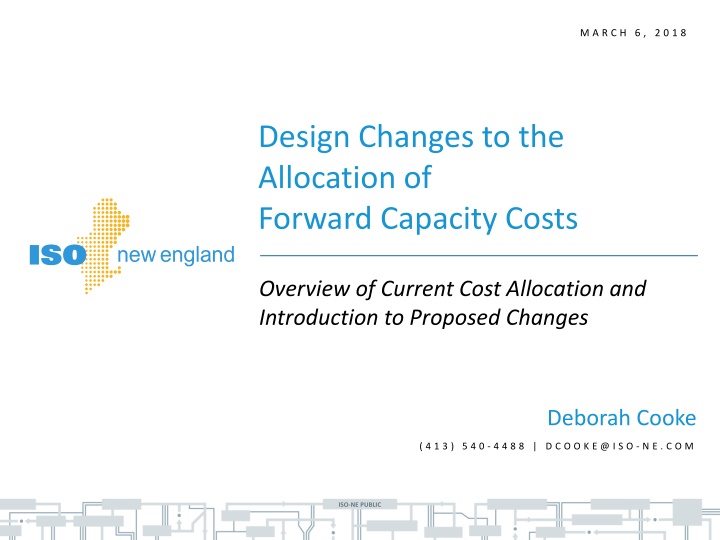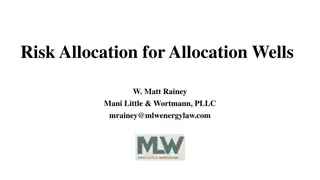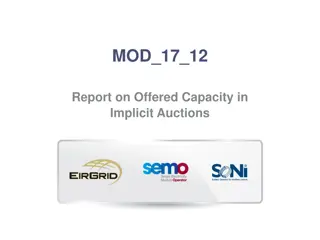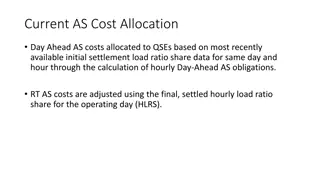Proposed Changes to Forward Capacity Cost Allocation
The document discusses proposed changes to the allocation of forward capacity costs effective June 1, 2020. It highlights the need for transparency in cost allocation, focusing on zonal demand curves and the Marginal-Reliability Impact. The current opaque method is critiqued for potential non-intuitive charges. The discussion outlines segments for introducing improvements in cost allocation, including a shift towards a marginal value cost approach.
Download Presentation

Please find below an Image/Link to download the presentation.
The content on the website is provided AS IS for your information and personal use only. It may not be sold, licensed, or shared on other websites without obtaining consent from the author.If you encounter any issues during the download, it is possible that the publisher has removed the file from their server.
You are allowed to download the files provided on this website for personal or commercial use, subject to the condition that they are used lawfully. All files are the property of their respective owners.
The content on the website is provided AS IS for your information and personal use only. It may not be sold, licensed, or shared on other websites without obtaining consent from the author.
E N D
Presentation Transcript
M A R C H 6 , 2 0 1 8 Design Changes to the Allocation of Forward Capacity Costs Overview of Current Cost Allocation and Introduction to Proposed Changes Deborah Cooke ( 4 1 3 ) 5 4 0 - 4 4 8 8 | D C O O K E @ I S O - N E . C O M ISO-NE PUBLIC
Project Title: Allocation of Forward Capacity Costs WMPP ID: 112 Proposed Effective Date: June 1, 2020 (Capacity Commitment Period 11) The allocation of costs to Capacity Zones were reviewed in light of the Marginal-Reliability Impact (MRI) based demand curves The current method to allocate Forward Capacity Market costs is opaque Current method is not transparent: all FCM costs are reflected in a zonal blended (average) price, which can result in non-intuitive charges For example, charge rates in an export-constrained zone can exceed the charge rates in import-constrained zones and/or Rest-of-Pool ISO-NE PUBLIC 2
The cost allocation changes will be discussed in segments The figure below is a road map for the discussions Three areas identified for conforming changes and/or improvements Introduction and overview of current cost allocation Conforming changes for zonal demand curves Allocation of certain costs to Capacity Zones Itemization of FCM charges Today s discussion focuses on the first two: Overview of current cost allocation How a participant s share of capacity costs is determined Net Regional Clearing Price approach, including discussion of Capacity Transfer Rights Introduction of the marginal value cost allocation approach ISO-NE PUBLIC 3
Current cost allocation method Net Regional Clearing Price A single monthly charge rate the Net Regional Clearing Price (NRCP) is calculated and used for cost allocation The NRCP reflects all costs associated with capacity transactions within each Capacity Zone Costs incurred in a Capacity Zone are allocated to load in that zone In each zone: the NRCP equals total payments to resources, divided by total CSO Capacity Transfer Rights (CTRs) are used to account for the imbalance between zones ISO-NE PUBLIC 4
The basics: What is the capacity charge? Four components: Specifically Allocated CTR Revenues ($) Export Credits and Charges * ($) Net FCM Charges ($) Capacity Charges ($) Residual CTR Fund ($) Part of today s discussion will focus on two components Capacity Charges Market Participant Allocator Charge Rate (Net Regional Clearing Price) Residual CTR Fund The export credit/charges is not covered No changes are proposed ISO-NE PUBLIC 5
MARKET PARTICIPANT COST ALLOCATION - Brief review of how a Market Participant s share of capacity costs is determined - No changes to this methodology are proposed, but proposing to clarify the terminology currently used and the specific data to be used in this calculation (inputs) ISO-NE PUBLIC ISO-NE PUBLIC ISO-NE INTERNAL USE 6
The Capacity Requirement is used in allocating capacity costs Based upon peak load contribution values in previous calendar years Calculated at both the Capacity Zone and Market Participant level, using similar formulas Capacity Requirement in a Capacity Zone (MW) = Pool CSO (MW) x Capacity Zone Peak ContributionCCP-2 (MW) Pool Peak ContributionCCP-2 (MW) Capacity Requirement for a Market Participant (MW) = Capacity Requirement in a Capacity Zone (MW) x Customer Average Peak ContributionCCP-1 (MW) Capacity Zone Peak ContributionCCP-1 (MW) Capacity Requirement, adjusted for self-supply, HQICCs, and Capacity Load Obligation Bilaterals ( Capacity Load Obligation ) is multiplied by the Net Regional Clearing Price to determine capacity charges ISO-NE PUBLIC 7
Simple examples demonstrate the Capacity Zone calculations Example 1: Capacity Zone Peak Load Capacity Requirement CSO Calculation MW MW MW ROP 6,000 5,100 6,000 x 5,100 5,100 6,000 Example 2: Capacity Zone Peak Load Capacity Requirement CSO Calculation MW MW MW Zone 1 2,000 2,300 6,000 x 2,300 5,100 2,706 Zone 2 1,000 600 6,000 x 600 5,100 706 Zone 3 3,000 2,200 6,000 x 2,200 5,100 2,588 Totals 6,000 5,100 6,000 Capacity Requirement (CR) = CSO (MW) x Zonal Peak Load (MW) System Peak Load (MW) ISO-NE PUBLIC 8
No changes to these calculations are proposed, but . The zonal and participant Capacity Requirement calculations use the peak contribution values from different periods Zonal uses the values from the calendar year two years prior to the commitment period ( CCP-2 ) Participant uses values from the calendar year immediately preceding the commitment period ( CCP-1 ) Original intent: consistency with the inputs used to calculate the ICR used in the third and final annual reconfiguration auction for the commitment period Inconsistent input that adds complexity without a clear benefit Recommendation: Use the peak contribution value from the calendar year immediately preceding the commitment period CCP-1 in all cases ISO-NE PUBLIC 9
Capacity Requirement term is confusing What s the problem with this term? Used to represent both Capacity Zone values and participant values, which may be confusing Often misinterpreted to mean Installed Capacity Requirement but no relation Misnomer - Not really a requirement Proposed name: Zonal Capacity Obligation Capacity Zone value (i.e., the obligation at the zonal level) Participant value will be share of Zonal Capacity Obligation Capacity Requirement will be used in this presentation while discussing how the present design works ISO-NE PUBLIC 10
REVIEW THE NET REGIONAL CLEARING PRICE (NRCP) APPROACH - Review the basic concept behind the Net Regional Clearing Price approach (the average cost approach) - Examine the workings of residual Capacity Transfer Rights (CTRs) and why this accounting tool is needed when there are different capacity zones - Show how the Net Regional Clearing Price becomes a blended rate when it includes other costs (for example, the outcome of an annual reconfiguration auction) - Finally, present an example that demonstrates the shortcomings of a blended, average cost approach to FCM cost allocation ISO-NE PUBLIC ISO-NE PUBLIC 11
What and how is load charged for capacity? Capacity charges are the zonal Capacity Requirement (soon to be called the Zonal Capacity Obligation) multiplied by the Net Regional Clearing Price The Net Regional Clearing Price is the average cost of capacity in a Capacity Zone For each Capacity Zone: Net Regional Clearing Price ($) Capacity Payments ($/kW-mo.) Capacity Requirement (MW) ISO-NE PUBLIC 12
Net Regional Clearing Price can be influenced by a number of factors Various CSO trading activities Forward Capacity Auction, annual and monthly reconfiguration auctions (additions and reductions in the amount of capacity in each zone) Other compensation rules (will be covered in more detail at the next meeting) Self-supply obligations Seasonal capacity variances of Intermittent Power Resources Specifically allocated Capacity Transfer Rights Payments to Interconnection Rights Holders of HQICCs Adjustments resulting from administrative actions Resource terminations (partial or full) ISO-NE PUBLIC 13
Example: Net Regional Clearing Price calculations Very simple, single zone example Only the Forward Capacity Auction clearing is included The NRCP is calculated as total payments divided by the total Capacity Supply Obligation (CSO) in the zone As our example only has one zone, the Net Regional Clearing Price equals the Capacity Clearing Price Capacity Supply Obligation Capacity Clearing Price Total Payments Net Regional Clearing Price Capacity Zone MW $/kW-mo. $K-mo. $/kW-mo. Rest of Pool 6,000 $8.000 $48,000 $8.000 Total Payments ($/mo.) = CSO (MW) x Capacity Clearing Price ($/kW-mo.) Net Regional Clearing Price ($/kW-mo.) = Total Payments CSO (MW) ISO-NE PUBLIC 14
The NRCP equals total payments divided by total CSO The NRCP is multiplied by the zonal Capacity Requirement (CR) to determine total charges As there were no additional trading activities or impacts from special compensation rules, the NRCP equals the Capacity Clearing Price Capacity Zone Capacity Charge CSO NRCP Peak Load CR MW $/kW-mo. MW MW $K-mo. Rest of Pool 6,000 $8.000 5,100 6,000 $48,000 Capacity Requirement (CR) = CSO (MW) x Zonal Peak Load (MW) System Peak Load (MW) Capacity Charge = NRCP ($/kW-mo.)] x CR (MW) ISO-NE PUBLIC 15
Lets add some complexity to our example: Multiple Capacity Zones Assume three capacity zones: import constrained (ICCZ), export constrained (ECCZ) and Rest of Pool (ROP) Capacity Clearing Price Capacity Zone CSO Total Payments NRCP MW $/kW-mo. $K-mo. $/kW-mo. ICCZ 2,000 $12 $24,000 $12 ECCZ 1,000 $6 $6,000 $6 ROP 3,000 $8 $24,000 $8 Total 6,000 $54,000 As in our previous example the NRCP equals the Capacity Clearing Pricein each zone ISO-NE PUBLIC 16
NRCP is used to calculate capacity charges for each Capacity Zone Capacity Charge Capacity Zone NRCP Peak Load CR $/kW-mo. MW MW $K-mo. ICCZ $12 2,300 2,706 $32,472 ECCZ $6 600 706 $4,236 ROP $8 2,200 2,588 $20,704 Totals 5,100 6,000 $57,412 But note that total charges collected from load in a month exceed the total payments to resources Charges of $57,412,000 exceed payments of $54,000,000 by $3,412,000 Why is there a difference and how is it distributed? ISO-NE PUBLIC 17
Some zonal capacity requirements were met by capacity resources outside a specific Capacity Zone In our example, 1,000 MW of capacity was purchased in ECCZ, but the zonal Capacity Requirement was only 706 MW Capacity Transfer Rights compensate for these differences Export constrained zones: Allocated to all load outside of the export constrained zone; the difference in capacity zone NRCPs multiplied by the difference in the CSO and Capacity Load Obligation (CLO) in the export constrained zone Import constrained zones: Allocated to load inside of the import constrained zone; the difference in capacity zone NRCPs multiplied by the difference in the CLO and CSO in the import constrained zone CLO is the Capacity Requirement (CR) adjusted for self-supply, HQICCs, and Capacity Load Obligation Bilaterals. For this presentation, CLO and Capacity Requirement are equal. ISO-NE PUBLIC 18
Calculating the Capacity Transfer Rights for each interface Capacity Transfer Rights NRCP Interface NRCP CLO CSO CLO/CSO $/kW-mo. $/kW-mo. MW MW MW $K-mo. Import $12 $4 2,706 2,000 (706) ($2,824) Export $6 $2 706 1,000 (294) ($588) Totals 6,000 3,000 ($3,412) The sum of the Capacity Transfer Rights equals the difference between payments and charges of $3,412,000! Capacity Transfer Rights, Import Interface = (NRCPICCZ NRCPROP) x (CSO CLO) Capacity Transfer Rights, Export Interface = (NRCPROP NRCPROP) x (CLO CSO) ISO-NE PUBLIC 19
The Capacity Transfer Rights are then allocated to each Capacity Zone Export Constrained Zone CTRs = $588,000 Allocated to load on the import side of the export constrained zone interface, pro rata based on CLO Import Constrained Zone CTRs = $2,824,000 This is allocated to load in the import zone Capacity Zone Share of Export CTR Capacity Zone Share of Import CTRs Total Capacity Zone CTR Capacity Zone CR MW $K-mo. $K-mo. $K-mo. ICCZ 2,706 ($301) ($2,824) ($3,125) ROP 2,588 ($287) ($287) Totals 5,294 ($588) ($2,824) ($3,412) Import Constrained Zone share of ECCZ Capacity Transfer Rights = CTRsECCZ x CRICCZ (CRICCZ + CRROP) Rest of Pool share of ECCZ Capacity Transfer Rights = CTRsECCZ x CRROP (CRICCZ + CRROP) ISO-NE PUBLIC 20
Capacity Charges at-a-glance Effective Charge Rate Residual CTR Allocation Capacity Zone Capacity Charge Total Charges NRCP Peak Load CR $/kW-mo. MW MW $K-mo. $K-mo. $K-mo. $/kW-mo. Inputs Calculations ICCZ $12 2,300 2,706 $32,472 ($3,125) $29,347 $10.845 ECCZ $6 600 706 $4,236 $4,236 $ 6.000 ROP $8 2,200 2,588 $20,704 ($287) $20,417 $ 7.889 Totals 5,100 6,000 $57,412 ($3,412) $54,000 Total Charges = Capacity Charge ($/mo.) + Residual CTR Allocation ($/mo.) ISO-NE PUBLIC 21
Lets add one more layer of complexity An annual reconfiguration auction Remember that the NRCP reflects all Forward Capacity Market transactions Activity from annual and monthly reconfiguration auctions, with multiple zones and different clearing prices, results in variances that must be allocated Example Inputs ARA CSO Transactions ARA Clearing Price ARA Credits / Charges Capacity Zone MW $/kW-mo. $K-mo. ICCZ (500) $13 ($6,500) ECCZ 0 $8 $0 ROP 500 $8 $4,000 Totals 0 ($2,500) ISO-NE PUBLIC 22
The NRCP reflects all Forward Capacity Market transactions The NRCP incorporates the reconfiguration auction variance ARA Credits / Charges Gross CR Charges Residual CTR Allocation Total Charges Capacity Zone FCA CSO Credits Total Credits Zonal CSO NRCP CR $/kW- mo. $K-mo. $K-mo. $K-mo. MW $K-mo. $K-mo. $K-mo. MW Inputs Calculations ICCZ $24,000 ($6,500) $17,500 1,500 $11.667 $31,570 ($4,723) $26,847 2,706 ECCZ $6,000 $0 $6,000 1,000 $6.000 $4,236 - $4,236 706 ROP $24,000 $4,000 $28,000 3,500 $8.000 $20,704 ($287) $20,417 2,588 Totals $54,000 ($2,500) $51,500 6,000 $56,510 ($5,010) $51,500 6,000 Total Credits = FCA CSO Credits ($) + ARA Credits/Charges ($) Gross CR Charges ($K) = CR (MW) x NRCP ($/kW-mo.) Total Charges ($) = Gross CR Charge ($) + Residual CTR Allocation ($) ISO-NE PUBLIC 23
Observations Overall cost of capacity decreased by $2,500 From $54,000 to $51,500 Suppliers in ICCZ pay to shed supply obligations This is reflected in lower costs and therefore lower NRCPs in ICCZ and ROP The CTR fund at the import interface increased significantly (from $3,125 to $4,723) why? Due to decreased CSO in the ICCZ, the average price (NRCP before CTRs) went up while the zonal Capacity Requirement did not change, so CTRS must be used to offset the higher NRCP ISO-NE PUBLIC 24
Comparison of NRCP with and without reconfiguration auction results FCA FCA and ARA Effective Charge Rate (w/CTRs) Effective Charge Rate (w/CTRs) Capacity Zone Difference in NRCPs CR NRCP NRCP MW $/kW-mo. $/kW-mo. $/kW-mo. $/kW-mo. $/kW-mo. $12.000 $11.667 ICCZ $10.845 $9.921 $0.924 2,706 $6.000 $6.000 ECCZ $ 6.000 $ 6.000 $0 706 $8.000 $8.000 ROP $ 7.889 $ 7.889 $0 2,588 Note that the NRCP includes credits/charges associated with the annual reconfiguration auction in this example NRCP can also include other credits/charges ISO-NE PUBLIC 25
The NRCP may have unintended consequences As shown in the annual reconfiguration auction example, costs incurred in one zone are fully allocated to that Capacity Zone Reflected in the NRCP What happens when no capacity is purchased in the export- constrained zone? Extreme example (and highly unlikely to occur), but serves to illustrate NRCP limitations Capacity is provided from outside the zone Change from basic example: Rest of Pool CSO increases and CSO in the ECCZ is reduced to 0 ISO-NE PUBLIC 26
No CSO in Export Constrained Zone Interesting Results!! Residual CTR Allocation Capacity Zone FCA CSO Credits Gross CR Charge Total Charges CSO CR NRCP MW $K-mo. MW $/kW-mo. $K-mo. $K-mo. $K-mo. Inputs Calculations ICCZ 2,000 $24,000 2,706 $12 $32,472 $63 $32,535 ECCZ 0 $0 706 $0 $0 $0 ROP 4,000 $32,000 2,588 $8 $20,704 $2,761 $23,465 Totals 6,000 $56,000 6,000 $53,176 $2,824 $56,000 Export Interface CTRs Calculation = (NRCPROP NRCPECCZ) x |CSO CLO| = ($8 - $0) x |0 706) = $5,648,000 Allocated to ICCZ and ROP pro-rata based on CLO; ICCZ also includes CTRs of ($2,824) for the import interface ISO-NE PUBLIC 27
What happened? No charges to load in the export constrained zone Where is the capacity associated with the ECCZ s zonal requirement? Using NRCP, only costs incurred in a zone are allocated to that zone This holds true for charges associated with annual and monthly reconfiguration auctions Why are CTR values positive? Charges collected based on NRCP reflect the $0 NRCP in ECCZ CSO credits > NRCP charge collections Remember, Capacity Transfer Rights are financial (balancing) instruments ISO-NE PUBLIC 28
What has been reviewed so far? NRCP is the average price of capacity in a zone Incorporates many different FCM components and pricing rules Does not incorporate the marginal value of capacity May not always allocate costs appropriately or intuitively Up next - an alternative cost allocation method ISO-NE PUBLIC 29
INTRODUCTION OF A MARGINAL VALUE COST ALLOCATION APPROACH - Demonstrate how the marginal value approach works with an example - Update the example to include the same annual reconfiguration auction example to show how other market activities will be included in this new approach - Show how this approach fixes the shortcomings of using a blended, average cost approach ISO-NE PUBLIC ISO-NE PUBLIC 30
Introduction As we ve just discussed, the NRCP cost allocation method does not reflect the marginal value of capacity Allocation is mainly based on silos costs incurred in one zone are allocated to that zone With the move to the MRI-based demand curves, which reflect the marginal value of capacity in each zone s clearing price, this design weakness may become more conspicuous Is there a different allocation method that better aligns with the MRI approach? Yes. ISO-NE PUBLIC 31
Capacity clearing prices reflect the reliability provided by purchased capacity in each zone The auction will clear capacity in a constrained zone based on the incremental value of capacity inside the zone, and will meet the resource adequacy objective by determining the most cost efficient mix of capacity from the various zones A MW in a constrained zone may be worth more or less than a MW outside the constrained zone The slope of the zonal MRI demand curves is not constant The marginal cost allocation method reflects the marginal reliability benefit of capacity Uses the clearing price to allocate auction costs to each Capacity Zone The cost allocation should reflect the zonal and overall (i.e., system) impact of purchased capacity on resource adequacy ISO-NE PUBLIC 32
Our simple example demonstrates the reliability allocation proposal Before going through the details of the formula a simple example will provide context Same example/inputs as the multi-zone NRCP example Three zones: Rest of Pool, import constrained and export constrained Auction Clearing Data: Capacity Clearing Price Capacity Zone CSO CSO Credits MW $kW-mo. $K-mo. ICCZ 2,000 $12 $24,000 ECCZ 1,000 $6 $6,000 ROP 3,000 $8 $24,000 Totals 6,000 $54,000 ISO-NE PUBLIC 33
Marginal Value Method (FCA Results) Simple Example Capacity Clearing Price Reliability Peak Load Allocator Reliability Peak Load Share FCA Capacity Zone CSO Credits FCA Charge Rate CR Capacity Zone Costs $K/mo. MW $/kW-mo. $K/mo. % $K/mo. $kW-mo. Inputs Calculations ICCZ $24,000 2,706 $12 32,471 57% $30,541 $11.287 ECCZ $6,000 706 $6 4,235 7% $3,984 $5.643 ROP $24,000 2,588 $8 20,706 36% $19,475 $7.525 Total $54,000 6,000 57,412 100% $54,000 Reliability Peak Load Allocator ($K/mo.) = CR (MW) x Capacity Clearing Price ($/kW-mo.)] 1000 Reliability Peak Load Share (%) = Reliability Peak Load Allocatorzone Total Reliability Peak Load Allocator (MW) FCA Capacity Zone Costs = Reliability Peak Load Share (%) x Total CSO Credits ($K/mo.) FCA Charge Rate = FCA Capacity Zone Costs ($) CR (MW) ISO-NE PUBLIC 34
The relative charge rates in each zone are equal to the relative credit rates in each zone For example, capacity purchased in the ICCZ is paid 150% more than capacity in rest-of-pool, and the load charge in the ICCZ is 150% higher than the charge rate in ROP % of Rest of Pool Charge Rate Total Supply Price % of Rest of Pool Price FCA Charge Rate Capacity Zone $kW-mo. % $kW-mo. % ICCZ $12.000 150% $11.287 150% ECCZ $6.000 75% $5.643 75% ROP $8.000 100% $7.525 100% But wait why are the charge rates less than the supply prices, in all zones??? ISO-NE PUBLIC 35
The charge rates reflect the reliability impact of capacity in all zones The zonal capacity requirement isn t equal to the CSO in each zone (e.g., ICCZ has a CR of 2,706 MW and CSO of 2,000 MW) Capacity zone charge rates are not calculated using how CSO is procured in each zone, rather the cost allocation is based on the value of capacity in each zone as reflected in each zone s total clearing price This approach proportionally adjusts the rate in all zones so the relative charge rates are directly proportional to the marginal reliability value in each zone (as reflected by the clearing prices) And the settlement balances without CTRs! ISO-NE PUBLIC 36
How does the marginal value approach work for annual reconfiguration auctions? The same way ARA Clearing Price Reliability Peak Load Allocator Reliability Peak Load Share ARA ARA Charge Rate Capacity Zone ARA CSO Transactions ARA Credits / Charges CR Capacity Zone Costs MW MW $kW-mo. $K-mo. $K/mo. % $K-mo. $kW-mo. Inputs Calculations ICCZ 2,706 (500) $13 ($6,500) 35,176 57% ($1,429) ($0.528) ECCZ 706 0 $8 5,647 9% ($230) ($0.325) ROP 2,588 500 $8 $4,000 20,706 34% ($841) ($0.325) Total 6,000 0 ($2,500) 61,529 100% ($2,500) Reliability Peak Load Allocator ($K/mo.) = CR (MW) x Capacity Clearing Price ($/kW-mo.)] 1000 Reliability Peak Load Share (%) = Reliability Peak Load Allocatorzone Total Reliability Peak Load Allocator (MW) ARA Capacity Zone Costs = Reliability Peak Load Share (%) x Total ARA Credits/Charges ARA Charge Rate = ARA Capacity Zone Costs ($) CR (MW) ISO-NE PUBLIC 37
Marginal Value Approach Effective Charge Rate FCA FCA Charge Rate ARA ARA Charge Rate Capacity Zone Effective Charge Rate CR Capacity Zone Costs Capacity Zone Costs MW $K-mo. $kW-mo. $K-mo. $kW/mo. $kW/mo. ($1,429) ($0.528) ICCZ 2,706 $30,541 $11.287 $10.759 ($230) ($0.325) ECCZ 706 $3,984 $5.643 $5.318 ($841) ($0.325) ROP 2,588 $19,475 $7.525 $7.200 ($2,500) 6,000 $54,000 The same calculations are applied to the reconfiguration auction results A separate charge rate is calculated Effective Charge Rate ($/kW-mo.) = FCA Charge Rate + ARA Charge Rate ISO-NE PUBLIC 38
Effective Capacity Charge Rate - Comparison Capacity Requirement Charges Effective Charge Rate Average (NRCP) Method Average (NRCP) Method Capacity Zone Capacity Requirement Marginal Method Marginal Method Difference Difference MW $K-mo. $K-mo. $K-mo. $/kW-mo. $/kW-mo. $/kW-mo. ICCZ $26,847 $29,112 ($2,264) $9.921 2,706 $10.759 ($0.837) ECCZ $4,236 $3,754 $481 $6.000 706 $5.318 $0.682 ROP $20,416 $18,634 $1,783 $7.889 2,588 $7.200 $0.689 $51,500 $51,500 $0 6,000 ISO-NE PUBLIC 39
And what if, in the FCA, no CSO is purchased in the export constrained zone? Better Results Capacity Clearing Price Reliability Peak Load Allocator Reliability Peak Load Share FCA FCA Charge Rate Capacity Zone FCA CSO Credits CR Capacity Zone Costs $K-mo. MW $/kW-mo. $K-mo. % $K-mo. $/kW-mo. Inputs Calculations ICCZ $24,000 2,706 $12 32,471 55% $30,912 $11.424 ECCZ $0 706 $8 * 5,647 10% $5,376 $7.616 ROP $32,000 2,588 $8 20,706 35% $19,712 $7.616 Total $56,000 6,000 58,824 100% $56,000 * The congestion price for the ECCZ is zero, and the Capacity Clearing Price is the same as Rest of Pool Reliability Peak Load Allocator ($K/mo.) = CR (MW) x Capacity Clearing Price ($/kW-mo.)] 1000 Reliability Peak Load Share (%) = Reliability Peak Load Allocatorzone Total Reliability Peak Load Allocator (MW) CR Charge = Reliability Peak Load Share (%) x Total CSO Credits ($K/mo.) FCA Charge Rate = FCA Capacity Zone Costs ($) CR (MW) ISO-NE PUBLIC 40
No CSO in the export constrained zone: Comparing the NRCP to the marginal value approach Load in all zones pay a share of the capacity costs Rest of Pool and ECCZ have the same charge rate In the absence of a separate clearing price, the ECCZ is priced at the system clearing price In the NRCP approach, the export constrained zone charge rate was $0 In the marginal value approach the export constrained zone charge rate is a function of the clearing price even if nothing clears in that zone ISO-NE PUBLIC 41
How does the marginal approach compare to the NRCP method for recent Forward Capacity Auctions? FCA 11 FCA 12 Effective Charge Rate Effective Charge Rate Marginal Value Method Marginal Value Method Capacity Zone NRCP Method NRCP Method CR Difference CR Difference MW $/kW-mo. $/kW-mo. $/kW-mo. MW $/kW-mo. $/kW-mo. $/kW-mo. SENE 15,090 $6.177 $6.103 ($0.074) 14,677 $5.634 $5.537 ($0.097) NNE 7,271 $5.261 $5.329 $0.068 7,072 $4.608 $4.661 $0.053 ROP 14,432 $5.592 $5.638 $0.046 14,037 $4.966 $5.045 $0.079 36,793 35,786 Reflects FCA results only no other trading activity has yet occurred (i.e., annual reconfiguration auction) ISO-NE PUBLIC 42
Conclusion Net Regional Clearing Price the average price of capacity in a zone Does not incorporate the marginal value of capacity May not always allocate costs appropriately or intuitively An alternate, marginal value approach addresses the shortcomings of using a blended, average cost approach ISO-NE PUBLIC 43
Summary and next steps Three general areas were identified where the cost allocation process might be improved Reviewed the first two sections today Recommended change to terminology (Capacity Requirement) and input to calculation (data from two years prior to the commitment period) Introduced alternative method that better allocates costs to capacity zones and aligns with the marginal reliability impact (MR) demand curves concepts Introduction and overview of current cost allocation Conforming changes for zonal demand curves Allocation of certain costs to Capacity Zones Itemization of FCM charges ISO-NE PUBLIC 44
Proposed Stakeholder Schedule Stakeholder Committee and Date Scheduled Project Milestone Initial meeting: Overview of current allocation; discussion of issues and proposed solutions for allocating costs to Capacity Zones Markets Committee March 6, 2018 Second meeting: Issues and proposed solutions to address zonal topology changes; improvements to the transparency of Forward Capacity Market charges Markets Committee April 2018 Markets Committee May 2018 Third meeting: Review proposed Tariff language Budget & Finance Committee May 2018 Conforming change to Section VII.C. of the Financial Assurance Policy Markets Committee June 2018 Vote Participants Committee June 2018 Vote ISO-NE PUBLIC 45
Deborah Cooke ( 4 1 3 ) 5 4 0 - 4 4 8 8 | D C O O K E @ I S O - N E . C O M ISO-NE PUBLIC 46
Acronyms Used in this Presentation CLO = Capacity Load Obligation CSO = Capacity Supply Obligation CTRs = Capacity Transfer Rights ECCZ = Export Constrained Capacity Zone FCM = Forward Capacity Market ICCZ = Import Constrained Capacity Zone MRI = Marginal Reliability Impact NRCP = Net Regional Clearing Price ROP = Rest of Pool ISO-NE PUBLIC 47























